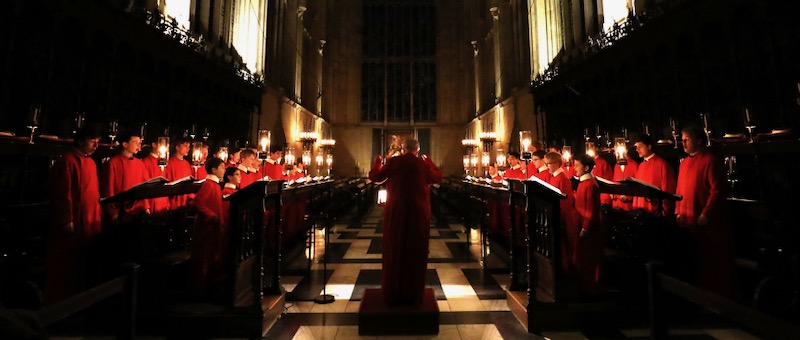The rude and the profane – how Christmas carols from ages past can brighten this bleak midwinter

King's College choir, pictured here during final rehearsals at King's College chapel in Cambridge, will sing its famous 'Nine Lessons' without a congregation.
Chris Radburn/PA
Christmas is going to have its job cut out to enliven the bleak midwinter of 2020. Out of concern for public health, festive celebrations are going to be circumscribed by the toughest government imposed regulations since the killjoy, Bible-bashing Puritans tried to ban Christmas observances altogether in the mid-seventeenth century.
Even the world famous Christmas Eve service of Nine Lessons and Carols from the late medieval chapel of King’s College, Cambridge, has fallen victim to Covid and will be celebrated for the first time in its history without a congregation. This isn’t going to be a “traditional” Christmas.
But to be perfectly honest, there isn’t that much about Christmas in secular, twenty-first-century Britain that’s particularly old. Most of our esteemed and seemingly time-sanctified traditions, such as the service at King’s, were actually invented within the past century or so – and that includes many of our Christmas carols, and where and when we sing them.
In fact, many of today’s favourite carols – Once in Royal David’s City, Away in a Manger, Good King Wenceslas, We Three Kings – aren’t actually carols at all but simply songs sung at Christmas. I’ll have to resort to scholarly pedantry in order to explain. To be a carol, a song has to have a specific, closely-defined structure, starting with an opening “burden” or chorus, which is then repeated after each stanza or verse. An excellent example is a fifteenth-century carol in praise of the Virgin Mary, There is no rose of such virtue (you can read the lyrics here, and listen to it being sung here).
It all goes back to the origin of carols as songs accompanied by a ring dance. The dancers would whirl around and sing the burdens, pausing to catch their breath while a cantor sang the stanzas.
In fact, the derivation of the word “carol” is probably the French word “carole” meaning a ring dance. The first use of carol in English dates to around 1300 and it was employed by Geoffrey Chaucer, England’s greatest medieval author, to mean a dance with a song.
Medieval carols were themed on a huge variety of subjects, including some far too rude to mention in The Tablet. But by the fifteenth century – when the dance element had been largely dropped – carols were already especially associated with Christmastide and close on half of the 500 or so carols that survive from the Middle Ages are, one way or another, concerned with the Virgin Mary and the Christmas season.
These include my very favourites, Nova, nova, Ave fit es Eva, a carol on the Annunciation, above, (I urge you to listen – I promise, you’ll be filled with joy and understand why carols were also originally dances), and the achingly sad Coventry Carol, below, a lullaby sung by a mother to her infant boy destined to be a victim of King Herod’s Massacre of the Innocents.
Carols often had an explicitly didactic purpose and were used by the Franciscans in their evangelising mission to Christ’s poor – what better way to stir the religious emotions of the populace than with a catchy tune such as that accompanying Angelus ad virginem. Although this medieval – and modern – favourite is in Latin, the language of the educated elite, the majority of carols were in English and were genuine expressions of late medieval popular piety and devotion. There are also a number of “macaronic” carols, composed using both the vernacular and a sprinkling of basic Latin that was probably quite widely understood.
Members of other religious orders also composed or documunted carols. Their number included John Audley, a blind chaplain at Haughmond Abbey and an anonymous monk of Battle Abbey who jotted down a carol about Christ’s suffering on behalf of mankind on the end pages of his breviary.
Indeed, many carols are known today thanks to the idle doodling of a medieval scribe, monk or nun, and only a very small percentage retain their original musical score. It seems likely the medieval “singing men” and choristers were adept at making up a toe-tapping tune on the spot.
You might be surprised to learn that, unlike today, carols weren’t sung during church services. A few especially fancy examples might have been sung during elaborate processions at grand cathedrals and monasteries, but there was no place in the medieval liturgy for carols, Christmas or otherwise. Rather, they were very much the preserve of more profane spaces, be it outdoors while wassailing door–to–door or during a Christmas feast in an elite household. Boar’s head, posh medieval tucker par excellence, even had its own carol. It’s still sung every year at the Christmas gaudy, or feast, at my alma mater, The Queen’s College, Oxford, as the roasted boar’s head bedecked with flag’s bearing the college’s arms, is processed to high table in the college’s hall.
Today, carol singing has reached its peak by Christmas Day and its rare to hear one after Boxing Day, or antiquarian that I am, St Stephen’s Day (for which there were several special medieval carols). It couldn’t have been more different in the Middle Ages. Christmas Day then marked the beginning, not the culmination of the festivities, which lasted the full Twelve Days through to the Epiphany and beyond. Our medieval ancestors would’ve been singing joyous Christmas carols until the octave of the Epiphany in mid-January. I can’t help but think they got it right: what better way to cheer up the dark, Covid-blighted early weeks of 2021 than with the jollity and merriment of Christmas and its promise of hope, peace, goodwill and the possibility of a better world.


 Votes : 0
Votes : 0









